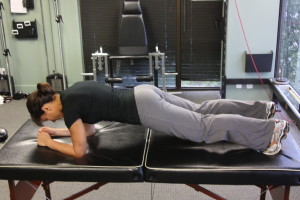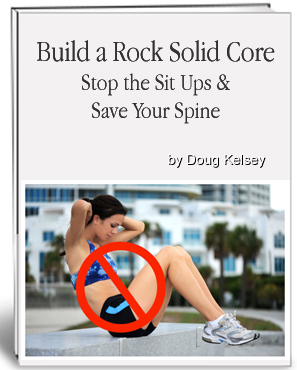- You are here:
- Home »
- Blog »
- Joint Health / Pain »
- Keep Your Back Feeling Good With This Exercise
Keep Your Back Feeling Good With This Exercise
What should you do to keep your back healthy and feeling good? Especially if you have a history of back trouble?
Or do you really need to do any at all? Could you just ignore the extra effort and time involved with an exercise plan and do just as well?
There’s a good chance, 80%, that in your lifetime you’ll have at least one episode of back pain that’s bad enough to take you out of your everyday activity.
The good news is that most people also feel better without surgery within a short period of time.
But, the muscles of your spine, deep down next to it, that help control small movements and keep the bones moving properly, become weaker very quickly during the back pain episode.
And, according to research, they don’t recover and regain their original strength without some help. ((Hides, J. A., M. J. Stokes, et al. (1994). “Evidence of lumbar multifidus muscle wasting ipsilateral to symptoms in patients with acute/subacute low back pain.” Spine 19))
So, what should you do?
You have to incorporate exercise to “wake up” these sleeping muscles. And one of the easiest and safest exercises to use is the plank.
How to Perform the Plank
- You’ll need a timer.
- From a hands and knees position, place your forearms on the floor and get up on your toes to so you assume the position in the photo.
 Keep your feet about shoulder width apart and your head in line with your trunk.
Keep your feet about shoulder width apart and your head in line with your trunk.- Start the timer.
- Hold the position as long as you can and note how long you held it.
- Rest for a minute.
- Do three sets per day.
Each day add, 5-10 seconds to the exercise. Once you reach two minutes, you can stop performing the drill.
Why The Plank Helps You
The great thing about the plank is that it forces your body to use all of the right muscles without you having to do anything special. The deep muscles of your spine are not under voluntary control like, for example, your hand.
You can move your hand around however your want but in the spine , the muscles react in concert with other muscles of the trunk.
So, in the plank position, certain abdominal muscles contract and cause the spine muscles to also contract. By holding the position and continuing the contraction of the abdominal muscles, your back muscles go to work.
Adding the 5-10 seconds per day increases the endurance of the muscles.
Beyond the Plank
Now that you can hold the plank for two minutes, you’re ready for something a little more challenging.
- From the plank position, take the right arm off the floor and place it next to the body so that the hand is next to the hip and then hold the position for as long as possible.
- Repeat the process of adding 5-10 seconds per day.
- Once you have mastered this position, try lifting the opposite leg off the floor (in this example the left leg). You’ll then be holding the plank position with only the left forearm on the floor and the right foot.
For a more in-depth exercise plan for back health, try my book, “Build a Rock Solid Core: Stop the Sit-Ups and Save Your Spine”.
Rock on.
What is “Build a Rock Sold Core?”
This is a 47 page, e-book (no physical product will be shipped) that includes:
- the seven drills you MUST drop from your training routine.

- detailed instructions on how to test your own core endurance.
- how to place yourself in the proper training category.
- an analysis and explanation of the “core”.
- the reasoning behind “strength” versus “endurance” for the core and why that matters to you.
- three ways to jump start your core in thirty seconds or less.
- specific drills based on your individual test scores and,
- how to progress your drills.
Regardless of your personal passions – sports, hobbies, or just being fit – a solid core is key.
Get “Build a Rock Solid Core” today!
